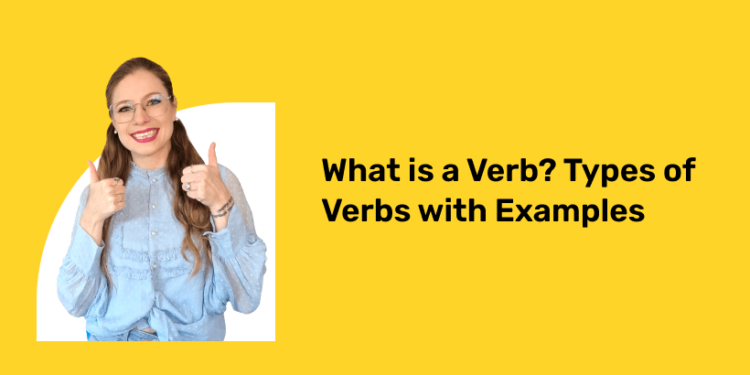Table of Contents
Verbs in English Grammar
In the English language, verb is an essential part of speech, without which it would be impossible to indicate what the subject is doing. It refers to all actions, including those related to feelings and emotions. Verbs come in different types and forms so that they can perform differently in order to provide complete meaning. Before we learn about the different types of verb and the verb forms, let us look at how various dictionaries define the term ‘verb’.
Definition of a Verb
1: Which of the sentences below is grammatically correct?
The Oxford Learners’ Dictionary defines a ‘verb’ as “a word or group of words that express an action (such as eat), an event (such as happen) or a state (such as exist)”. According to the Cambridge Dictionary, a ‘verb’ is defined as “a word or phrase that describes an action, condition, or experience”. The Collins Dictionary provides a much more elaborate definition of a verb. According to them, “A verb is a word such as ‘ sing’, ‘ feel’, or ‘ die’ which is used with a subject to say what someone or something does or what happens to them, or to give information about them”.
Join our Spoken English program today and communicate with ease!
General Classification of Verbs according to What They Signify
Before we get into a broad classification, let us first have a look at how verbs can be classified generally according to what kind of action they signify.
Verb referring to action (action verbs) are those that involve the movement of one’s body in one way or the other. Some examples of verb referring to actions are as follows:
- Walk
- Run
- Talk
- Sit
- Read
- Write
- Jog
- Cough
- Sleep
- Jump
- Sing
- Drink
- Teach
- Present
- Build
- Break
- Tow
- Toss
- Hug
- Fight
Verb Referring to Experiences or Feelings
These are verbs that refer to something that you can feel or experience and do not necessarily involve a movement of any kind. Some examples of verb referring to feelings and experiences are as follows:
- Love
- Hate
- Envy
- Believe
- Trust
- Feel
- Entrust
- Experience
- Care
- Cherish
- Sense
- Know
- Recognize
- Understand
- Comprehend
- Like
- Need
- Adore
- Appreciate
Elevate your speaking skills with our Spoken English Course!
Verbs Referring to a State or Condition
These verbs are those that refer to situations or the state of being. All forms of ‘to be’ verbs belong to this category. Some examples of verb referring to a state or condition are as follows:
- Am
- Is
- Are
- Was
- Were
- Have
- Has
- Will be
- Appear
- Seem
- Become
- Been
- Being
The Various Types of Verbs with Examples
Verbs can be classified into numerous types according to their function or role in a sentence or context. Let us look into the various types of verbs and some examples of each type of verb.
Auxiliary Verbs/Helping Verbs
Auxiliary verbs or helping verbs, as the name suggests, is a verb that is used to help another verb sound sensible and meaningful. It is used to change the other verb’s tense, mood or voice. So, every time an auxiliary verb is used, you always have one more verb, which acts as the main verb in a sentence.
Examples of auxiliary verbs are as follows:
- Am
- Is
- Are
- Was
- Were
- Have
- Has
- Do
- Will
- Can
When you use auxiliary verbs, you should conjugate the auxiliary verb correctly according to the tense form of a sentence. Another specific fact about auxiliary verbs is that they can also be used as a main verb. Also, there are verbs called modal verbs that can be used as a helping verb.
Modal Verbs
Modal verbs are those verbs that are used to denote the possibility, probability, capability or necessity of something happening. Modal verbs, unlike other auxiliary verbs, cannot be used as a main verb in a sentence.
Examples of modal verbs are as follows:
- Can
- Could
- Will
- Would
- May
- Might
- Should
- Must
- Ought to
Join our Spoken English program today and communicate with ease!
Phrasal Verbs
Phrasal verbs include phrases that are formed by combining two or more parts of speech that performs the same function as a verb in a sentence. In most cases, a phrasal verb results from a combination of a verb and a preposition.
Some examples of phrasal verbs are as follows:
- Go by
- Lay off
- Log in
- Get off
- Run out
- Go all out
- Think through
- Fed up
- Taken aback
- Act on
- Back away
- Back up
- Look up
- Mix up
- Opt out
- Pop in
Check out the list of phrasal verbs and exercise on phrasal verbs.
Linking Verbs
A linking verb, just like the name suggests, is a type of verb that is used to link the subjects in a sentence to the other parts of the sentence so that it is meaningful. It connects the subject to the object, an adjective and even a prepositional phrase. All ‘to be’ forms of verbs and verbs like ‘seem’ and ‘become’ can act as linking verbs.
Have a look at the following examples to understand how verbs perform the role of a linking verb in sentences.
Example 1: Connecting Nouns to Other Nouns in a Sentence
Danny is my brother.
In the above example, the verb ‘is’ is used to connect the subject ‘Danny’ as the ‘brother’ of the speaker. In this sentence, the words ‘Danny’ and ‘brother’ are used to refer to the same person.
Example 2: Connecting a Noun to a Prepositional Phrase in a Sentence
The children were in the park.
In Example 2, the verb ‘were’ is used to connect the subject ‘the children’ to the prepositional phrase ‘in the park’.
Example 3: Connecting a Noun/Subject to an Adjective
Your presentation of the life cycle of the silkworm was excellent.
In the above example, the verb ‘was’ is used to link the subject ‘Your presentation of the life cycle of a silkworm’ to the adjective ‘excellent’.
Example 4: Connecting the Subject/Noun to the Predicate using Seem/Become
This book on a treasure hunt seems interesting.
In this sentence, the subject ‘This book on a treasure hunt’ is connected to the adjective ‘interesting’ with the linking verb ‘seem’.
The students became bored after two continuous hours of classes.
In the above sentence, the subject ‘The students’ has been linked to the rest of the sentence with the linking verb ‘became’.
Different Categories of Verbs
Verbs can be divided into different categories according to their behaviour when used in a context. Let us look at the categories explained below.
Regular Verbs and Irregular Verbs
As you can see, verbs are used to denote actions, and they can be used in different forms to indicate when the subject in a sentence is carrying out an action. A regular verb can be conjugated to show if the action takes place in the past or if the action is taking place continuously.
In most cases, the past form of the verb is formed by adding an ‘ed’ to the root verb for regular verbs. On the other hand, there are other verbs that do not follow this rule. They are called irregular verbs. These verbs have their own unique forms.
Have a look at the examples given below.
- Dileep searched for his white shirt in his cupboard, but he did not find it. (Root verb – search)
- Did you find the book you were looking for?
In the above examples, the verb ‘searched’ is the past form of the regular verb ‘search’ by adding an ‘ed’ and the verb form ‘looking’ indicates the continuous form of the regular verb ‘look’ by adding an ‘ing’ to the end of the root verb.
- Selena read the book on the evolution of life on earth.
- Vineeth found the keys that went missing yesterday.
In the above examples, the verb ‘read’ stays the same in the past form and when used as a past participle. ‘Found’ is the past form of the root verb ‘find’.
Transitive Verbs and Intransitive Verbs
Transitive and intransitive forms of verbs are used to denote how a verb acts when used with a direct object and an indirect object. Let us look at a few examples.
- Vincent gave a box of chocolates to his brother. (Indirect object – his brother, Direct object – a box of chocolates)
- Garry passed the water bottle to Kevin, who was sitting in the first row. (Indirect object – Kevin, Direct object – the water bottle)
- The little girl ran around the park for two hours.
- Francey walked to school every day.
- My mom cleaned the house today. (Direct object – the house)
- Seena did not like the movie. (Direct object – the movie)
In the above examples, the verbs ‘gave’ and ‘passed’ in the first two sentences are seen to take a direct object and an indirect object, whereas the verbs ‘ran’ and ‘walked’ take no object at all. In the last two sentences, the verbs ‘cleaned’ and ‘did not like’ take a direct object and no indirect object.
Verbs that take a direct object alone are called transitive verbs, and those verbs that do not take either a direct object or an indirect object are called intransitive verbs. There is yet another category of verb that take both the direct object and the indirect object, and they are called ditransitive verbs.
Elevate your speaking skills with our Spoken English Course!
Verb Forms
A verb is used in different ways to indicate the time in which the subject is performing an action. There are various verb forms that are used to do the same. Let us look at the different verb forms explained below.
Root Verb
The raw or original form of the verb, how it originally exists in the English language, without any inflexions or conjugations, is called the root verb.
Some examples of root verbs are as follows:
- Eat
- Sit
- Stir
- Type
- Read
- Fry
- Tick
- Shift
- Trick
- Sing
Simple Present – Third Person Singular
The third person singular form of the verb in the present tense is mostly the verb in the singular form. When using the third person singular pronouns such as he, she and it, and the nouns that can be substituted by the third person singular pronouns, the verb is singular (mostly done just by adding an ‘s’ to the root verb) so that it agrees with the subject in the sentence.
For example:
Kenny likes to have mangoes after every meal. (The noun ‘Kenny’ can be substituted with the third person singular pronoun ‘he’)
The cat chases every rat it catches sight of. (The noun ‘The cat’ can be substituted with the third person singular pronoun ‘it’)
She hates going to work on Saturdays and Mondays.
Present Participle
The present participle is used in the continuous form of tenses to indicate an action that is continuing or in progress at that particular moment or sometime in the past or in the future. These words are formed just by adding an ‘ing’ to the root verb. For verbs ending with an ‘e’, in most cases, the present participle is formed by removing the ‘e’ and then adding ‘ing’ to the remaining portion of the verb.
For example:
Jhanvi is watching a movie along with her cousin. (Present Continuous Tense)
My mother is baking cakes (Present Continuous Tense)
All my brothers were playing dodgeball in the evening. (Past Continuous Tense)
Simple Past
There is a change in the spelling of the root verb when it is used to indicate the simple past tense form of the verb. There is no one rule to write a verb in the simple past tense; it changes for each verb – some verbs like ‘give’ and ‘bring’ take a different spelling, and some verbs like ‘cut’ and ‘put’ remain the same when used in the past tense. However, most verbs can be made into the past tense by adding an ‘ed’ at the end of the root verb.
For example:
- The doctor asked me to take tablets for ten days. (The rook verb here is ‘ask’)
- Nelson bought the car he checked out last week. (The root verbs here are ‘buy’ and ‘check’)
- The baby drank the milk completely. (The root verb here is ‘drink’)
Past participle
The past participle form of the verb is used to denote the perfect tense forms in a sentence. In some cases, the past tense and the past participle remain the same, but there are a number of verbs that have different spellings when used as a simple past tense verb and a past participle.
For example:
- I have searched the entire loft for that box, but I did not find it. (The root verb here is ‘search’, ‘have searched’ is the verb in the sentence that indicates the perfect tense and ‘searched’ is the past participle)
- Dylan had read the book already.
In the above example, the root verb here is ‘read’, ‘have read’ is the verb in the sentence that indicates the perfect tense and ‘read’ is the past participle. In this case, all forms of the verb take the same spelling but have a different pronunciation.
Gerunds
Any verb can be transformed into a gerund by adding ‘ing’ to the root verb. Gerunds, when it stands by themselves, can be used as nouns. A gerund can be used as a verb when used with an auxiliary verb to indicate an action that is continuing at a particular period of time.
For example:
- He is eating an apple.
- Joy will be coming home next week.
- Walking every day is good exercise.
- Drinking and driving is dangerous.
Infinitives
Infinitives, like gerunds, can be used to turn verbs into nouns by adding a preposition ‘to’ in front of the root verb.
For example:
- Would you like to have something?
- I like to dance in my free time.
- I am going to talk to my friend.
Active Voice and Passive Voice
According to the position of the subject and object in a sentence, the voice of the verb can be determined. A sentence in which the subject does the action is called the active voice, and a sentence in which the indirect object or the direct object is switched to make it the subject is called the passive voice.
For example:
- Active Voice – The doctor checked the patient.
- Passive Voice – The patient was checked by the doctor.
Conjugating Verbs in the English Language – Tense Forms
Verbs can be conjugated to denote the tense you need. There are four tense forms, namely the simple tense, the continuous tense, the perfect tense and the perfect continuous tense. These tense forms are used to represent three time periods such as the present, past and future, thereby forming twelve main tense forms in total.
Frequently Asked Questions on Verbs in English Grammar
What is a verb?
Verbs happen to be an essential part of speech, without which it would be impossible to indicate what the subject is doing. It refers to all actions, including those related to feelings and emotions. Verb comes in different types and forms so that they can perform differently in order to provide complete meaning.
What is the definition of a verb?
The Oxford Learners’ Dictionary defines a ‘verb’ as “a word or group of words that express an action (such as eat), an event (such as happen) or a state (such as exist)”. According to the Cambridge Dictionary, a ‘verb’ is defined as “a word or phrase that describes an action, condition, or experience”. The Collins Dictionary provides a much more elaborate definition of a verb. According to them, “A verb is a word such as ‘ sing’, ‘ feel’, or ‘ die’ which is used with a subject to say what someone or something does or what happens to them, or to give information about them”.
What are the types of verbs?
Verbs can be generally classified into three main categories with reference to what they signify, such as verbs referring to actions, verbs referring to experiences or feelings and verbs referring to a state or condition. Furthermore, it can be classified into auxiliary verbs (otherwise called helping verbs), modal verbs, phrasal verbs and linking verbs.
What are the different verb forms in the English language?
In the English language, there are eight to nine verb forms which include the root verb, the third person singular present form of the verb, the present participle, the simple past, the past participle, the gerunds, the infinitives, the active voice and the passive voice.
Elevate your speaking skills with our Spoken English Course!
Related Articles
| Vegetable Names with pictures | 50+ Fruit Names in English |
| List of 20+ Names of Colours in English | Rhyming words |
| Interrogative Sentences | Degrees of Comparison |
| Adverbs | Verbs |










